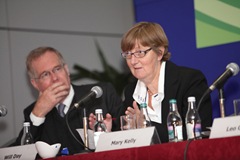The green challenge
 In these times of unprecedented economic crisis the Environmental Protection Agency (EPA) is focused on keeping the environment centre stage. Owen McQuade caught up with the Agency’s Director General, Dr Mary Kelly, to discuss the state of Ireland’s environment and the key challenges ahead.
In these times of unprecedented economic crisis the Environmental Protection Agency (EPA) is focused on keeping the environment centre stage. Owen McQuade caught up with the Agency’s Director General, Dr Mary Kelly, to discuss the state of Ireland’s environment and the key challenges ahead.
The EPA is perhaps best known in its role as a regulator but in fact many of the tasks that the agency is involved in include assessing, monitoring, measuring and reporting on the environment. The EPA’s Director General, Mary Kelly, believes that one of the most important roles the agency has is reporting on the state of the Irish environment: “It is important to have a record of the Irish environment over the years so that we can see whether it is maintaining, improving or disimproving and so that we can take policy measures or take policy interventions that might change the trends.”
An important part of what the EPA does is using these indicators to assess what has happened in the past, what’s likely to happen in the future and to inform policy. “In that context, we work very closely with colleagues in the Department of the Environment and other departments to try and do just that,” adds Kelly.
The EPA undertakes a major report on the ‘State of the Environment’ every four years. The report informs policy makers’ thinking not just in the environment area but across the broader sphere of government. “We find that it makes its way into very many policy documents of other departments and agencies in the intervening four years,” observes Kelly.
The agency also produces indicator reports in the intervening two years of the four yearly cycle. Although there is less analysis in the interim reports, they continue to show the trends in the chosen indicators.
At this year’s Environment Ireland conference the EPA launched a web based indicator reporting series. Kelly says that the idea behind the website is “to make the indicators available to a wider audience.”
“It allows us also, instead of a four year cycle, to produce much more timely information. In other words we are able to update the web material much more quickly that the paper based material,” she adds. There are 43 indicators under a number of headings ranging from waste and water, nature, the air and climate change to socio-economic indicators.
How are we doing?
Kelly runs through the indicators from the website, which uses a ‘smiley-face’ indicator system. The indicator showing bio-degradable waste is going down, but Kelly observes that “a lot of this is due to the recession. So, we’ve got to decouple economic growth from our waste production and waste disposal.” The indicator demonstrates for policy makers that something has got to be done to meet the 2016 biodegradable waste target even though we are currently going in the right direction.
Looking at greenhouse gas projections, which were used by the Environment Minister in his carbon budget and in predictions for the EU and others, you clearly can see that in the best case scenario, Ireland is still not going to meet its 2020 target. Kelly states the scale of the challenge in meeting this indicator: “If you include all the initiatives or policies that are in place or are planned, or if you do the extra ones which includes carbon sinks, neither of them – even the more ambitious one – gets us to the target.”
Kelly emphasises that although the indicators are useful in determining future actions, some caution is, on occasion, required in interpreting them. With afforestation the target is to have 30 per cent of afforestation broad leaf plantation and it looks like we will meet that target. However when you actually look at the indicator you see that afforestation is going down, but it is going down because coniferous planting is going down, not necessarily because the broad leaf is going up. “So you can see that you could be getting your green smiley face and meeting your targets, but perhaps not in the way you want to be,” she adds.
On looking through all the indicators Kelly is “quite worried” that the percentage of high ecological quality waters is decreasing dramatically over the last few years: “We are very concerned because our pristine waters [are] disappearing rapidly and we need to take measures under the Water Framework Directive and other policy areas that will reverse that trend.”
Reviewing the indicators, the EPA has identified a number of challenges for the environment going forward.
The first is complying with environmental legislation and agreements, at individual, company or local authority and national level.
“Making sure that Ireland is in compliance with its international agreements is equally important to making sure that companies comply with the conditions of their licenses,” Kelly insists.
“The mainstreaming of environmental considerations into policy areas has been, for quite a number of years and through many ‘State of the Environment’ reports, a big issue for the EPA.” She adds: “I’m glad to say that I think we finally have achieved that. I think people in other departments and other agencies ‘get’ the environment now.”
Kelly sees limiting and adapting to climate change as one of the big challenges. “What we need to do really, is reduce our dependence on fossil fuels. We need significant increases in energy efficiencies and to be looking at the use of alternative energy resources. And we need radical changes in practice in all economic sectors; energy, transport, agriculture, and our own lives,” she observes.
“This is about a behaviour change, particularly on climate change and waste. Lots of the environmental issues of the day are about a change in behaviour.”
Kelly says that there needs to be a “concerted” series of adaptation measures including flood prevention and control, better management of water resources and the use of green infrastructure, such as wetlands used as flood plains and afforestation used to absorb carbon dioxide.
“We need an improved understanding of climate change. The more we understand it, the more we are able to tackle directly what we need to do.”
Reversing environmental degradation is another important challenge: “We report that generally Ireland’s environment is in good shape and I think anyone who spent their holidays in Ireland this summer would say ‘Ireland is a beautiful place and the environment looks very good.’ And it is very good in most cases.”
However, the EPA has identified from these indicators and from its ‘State of the Environment’ report, particular areas that need work.
One of them is utrification and other water pollution. “Over 29 per cent of our river catchment and 15 per cent of our lakes are in what we determine to be an unsatisfactory condition. Nitrate levels in ground water particularly in the East and South East are a concern and a lot of it is coming from municipal, agricultural and other causes. We feel that that’s an area that needs to be tackled,” Kelly states.
There is also “the unsatisfac
tory status of natural habitats and species.” Kelly points out that “there is direct habitat damage in some cases, water pollution, unsustainable exploitation and recreational pressure on the environment.”
“We haven’t designated as a country an adequate number of protected sites yet,” Kelly adds.
She believes that we need clear conservation targets for sites. “They need to be set out very clearly and then they need to be implemented.”
Kelly sees the need for the identification, management and remediation of contaminated lands.
In addition she says that Ireland needs a strong culture of compliance with regulation: “We need to become more environmentally aware and change our behaviour. We have a continued need for a higher and more consistent standard of enforcement right across the sectors.
“We have a very difficult challenge in meeting many of our international environmental protection obligations, but meet them we must. The reason why we must is apart from the financial consequences, which the EU will impose on us eventually, our reputations are at stake here.”
She sees progress in the mainstreaming of environmental considerations. “There is more of a realisation today that economic well-being is intrinsically liked to a clean and protected environment, that the economic vibrancy of several sectors are closely linked to Ireland’s clean and green image; tourism, agriculture, food.”
Economy and environment
Realising the potential of the green economy is now “vital” for the recovery of the economy.
“There is a huge opportunity to move towards a sustainable economy. We can, and should be looking at this green area in terms of trying to give a boost to the economy. If you look at the strategies that are coming from the various departments and agencies, they are all building in the idea of a green future. There is consensus, but are we doing anything about it?”
Kelly details the progress to date: “We are looking at a smart grid. An electric vehicle pilot project is underway. Renewable energy is under development. On the waste side we’ve had the roll out of brown bins which means jobs in the processing of waste materials. Our licensing process has moved away from huge infrastructure to licensing transfer stations and treatment plants. We have achieved higher recycling rates which is giving us both jobs and resource.”
“Yes we have made progress,” she concedes. “But if we look back to the challenges – environmental, economic and social – we need to transform the economy so our recovery is a low carbon, green recovery. That means greening products, services and energy.”
Kelly warns that: “Developing these export led green technologies and services sector in a very constrained budgetary context will require imagination, innovation, new ways of working and new behaviours.”
Ultimately, a green economic recovery will require “investment and huge determination to succeed.”
Profile: Mary Kelly
Mary Kelly is Director General of the EPA. She studied organic chemistry to PhD level at Trinity College Dublin and worked in the pharmaceutical industry for a number of years after graduation. She completed an MBA at Dublin City University and took charge of environmental policy at IBEC, where her interest in the subject really took off. This role involved sitting on an advisory committee to the EPA and she was involved in helping industry understand integrated pollution control licensing during its initial stages. Kelly joined the EPA as Director-General in 2003.






